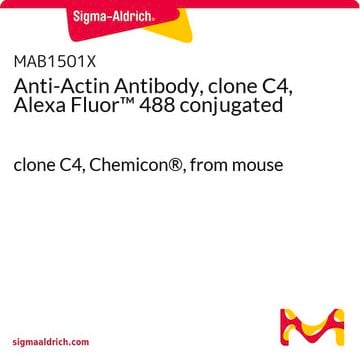MAB1501R
Anti-Actin Antibody, clone C4
clone C4, Chemicon®, from mouse
Synonym(s):
actin, alpha 1, skeletal muscle, alpha skeletal muscle actin, MAB1501, MAB1501X, smooth muscle actin, SMA
About This Item
Recommended Products
biological source
mouse
Quality Level
antibody form
purified antibody
antibody product type
primary antibodies
clone
C4, monoclonal
purified by
using protein G
species reactivity (predicted by homology)
all
manufacturer/tradename
Chemicon®
technique(s)
ELISA: suitable
immunocytochemistry: suitable
immunohistochemistry (formalin-fixed, paraffin-embedded sections): suitable
western blot: suitable
isotype
IgG2bκ
NCBI accession no.
UniProt accession no.
shipped in
wet ice
target post-translational modification
unmodified
Gene Information
human ... ACTA1(58)
General description
Specificity
Application
10 μg/mL dilution from a previous lot was used (methanol fixed mouse 3T3 cells).
Immunohistochemistry:
10μg/mL dilution from a previous lot was used for paraffin embedded, 4% formaldehyde, 3% glutaraldehyde, sodium cacodylate treated sections {see Luciano, L et al. 2003}.
ELISA:
A previous lot was shown to be strongly reactive with the cytoplasmic actin and shows a significant binding to gizzard, skeletal, arterial and cardiac actins. Also shows a significant binding to both Dictyostelium discoidum and Physarum polycephalum.
Western blot:
1-20 µg/ml. On muscle homogenates subject to SDS-PAGE, reacts relatively uniformly with a 43 kD protein present in skeletal, cardiac, gizzard and aorta tissues. Appears to react with all isoforms of actin found in these preparations and shows a strong reaction with the alpha-actin found in skeletal, cardiac, and arterial muscle (Otey, 1987).
Immunohistochemistry:
10µg/mL for paraffin embedded, 4% formaldehyde, 3% glutaraldehyde, sodium cacodylate treated sections {see Luciano, L et al. 2003}.
Optimal working dilutions must be determined by end user.
Quality
Western Blot Analysis:
1:1000 dilution of this lot detected actin on 10 μg of HeLa lysate.
Target description
Physical form
Legal Information
Not finding the right product?
Try our Product Selector Tool.
recommended
Storage Class Code
12 - Non Combustible Liquids
WGK
WGK 1
Flash Point(F)
Not applicable
Flash Point(C)
Not applicable
Certificates of Analysis (COA)
Search for Certificates of Analysis (COA) by entering the products Lot/Batch Number. Lot and Batch Numbers can be found on a product’s label following the words ‘Lot’ or ‘Batch’.
Already Own This Product?
Find documentation for the products that you have recently purchased in the Document Library.
Customers Also Viewed
Our team of scientists has experience in all areas of research including Life Science, Material Science, Chemical Synthesis, Chromatography, Analytical and many others.
Contact Technical Service









